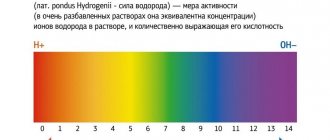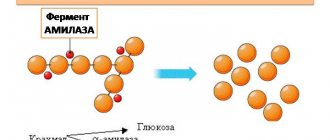The concept of general urine analysis includes the determination of its physicochemical and biochemical properties, as well as sediment microscopy. It is considered a classic method for diagnosing diseases of the kidneys and other organs, and is also prescribed during an annual preventive examination. Why take a urine test, what abnormalities in a person’s condition will it show?
- Inflammatory, autoimmune, metabolic, oncological diseases of the kidneys and urinary tract;
- Endocrine disorders - diabetes mellitus, hyperfunction of the parathyroid gland, Cushing's syndrome;
- Changes in the acid-base state of the body - acidosis and alkalosis;
- Dehydration (dehydration) with prolonged vomiting and diarrhea, fever, fasting;
- Gestosis in pregnant women, eclampsia;
- Poisoning with salts of heavy metals, phenol, aniline, ethylene glycol, poisonous mushrooms, snake venom, drugs, etc.;
- Other diseases - gout, myeloma, paroxysmal nocturnal hemoglobinuria, Fanconi syndrome, hemolytic anemia, obstructive jaundice, hepatitis, etc.
Also, its prescription is justified for dynamic monitoring of the effectiveness of treatment, monitoring the course of the disease and the occurrence of complications.
Data from a general urine test are always considered in conjunction with the symptoms of the disease and the results of other laboratory tests.
pH standards
Normal acidity is a rather broad term that does not give a complete picture of the state of the body at the moment due to the influence of numerous factors.
There are generally accepted indicators, going beyond which is characterized as the presence of pathology. For urine, the pH will range from 5.0 to 7.0. Short-term fluctuations in acidity from 4.5 to 8.0 can be considered normal if they are short-term and there are no alarming symptoms such as polyuria, oliguria or pain when urinating.
Also, pH values fluctuate depending on the time of day, degree of physical activity, individual characteristics of the body or diet. For example, in the morning the pH is 6-6.5, and in the evening the acidity rises to 7. In addition, the ratio of the liquid secreted to the liquid drunk is of great importance.
Optimal acidity levels in men may be higher than in women due to a higher percentage of muscle mass, as well as a dietary pattern that involves consuming more meat products. Be that as it may, the optimal generally accepted acidity value for adults is in the range from 6.3 to 6.5.
In women during breastfeeding, this figure can rise to 7.8. As a result of the high level of metabolism for newborn children, the acidity numbers will be completely different. The average baby has a urine pH level of 5.4 to 5.9 units, and for premature babies it is 4.8 to 5.4.
Urine pH during pregnancy and the gender of the child
On online forums you can often come across the question: urine pH during pregnancy and the gender of the child . Can you tell from urine pH whether the baby is a boy or a girl? There is a myth that a pregnant urine pH of 5-6 means the birth of a girl, and 7-8 means a boy. But just... the key word is “fortune teller”. This type of advice is displayed on forums and portals along with advice on how to find out the gender of a baby using baking soda or watching a wedding ring spin on a string over the mother's belly. Therefore, you should not trust such practices.
Rules for using test strips
Does beets affect the color of urine: is it good or bad?
Urine pH can be easily determined using reagent test strips at home.
Preparation for the procedure:
- When removing strips, do not touch the indicator part of the plate with your fingertips.
- Collect the morning urine sample in a sterile container, after performing an external hygienic toilet of the genitals. Do not take the test during your period.
- Stir the urine, eliminating possible sediment.
- Conduct diagnostics at temperatures from 15 to 25 degrees. Lower environmental figures may cause false readings.
- Do not use urine collected more than 2 hours ago. The error in values in this case is up to 50%.
- Do not use the strip more than once.
- Do not keep the plate in urine for more than the time specified in the instructions to avoid obtaining incorrect test results.
- Do not use devices that have expired.
- Avoid exposure of ultraviolet rays to the diagnostic color scale located on the tube.
Carrying out the procedure:
- Carefully remove the strip from the plastic box.
- Stir the urine, eliminating the sediment of salts.
- Immerse the plate in the container for 1-3 seconds.
- Remove the indicator, remove excess sorbent liquid, or tap the strip on the edge of the container.
- Place the test on a dry surface with the reagent side up.
- Assess the value of the indicators after 1-3 minutes. according to the color scale: orange – 4.9-5.0; saturated yellow – 6.0; pale yellow – 6.5; light green – 7.0; pale green – 7.5; emerald – 8.0; swamp green – 8.5.
- The waiting time for results should not be exceeded. Analysis values can change significantly under the influence of air and ultraviolet radiation.
Acidity is determined once every 3-4 days. It is advisable to conduct the study at the same time (immediately after getting up in the morning), since the numbers vary greatly throughout the day. If the indicators shift over 2 weeks towards acidification or alkalization, you must consult a general practitioner and undergo a comprehensive medical examination
Self-determination of pH
It is impossible to objectively assess the level of urine acidity through a single analysis. If indicators of acidification or alkalization occur, it is necessary to monitor the pH. Self-assessment is mandatory for people with chronic pathologies:
- diabetes;
- chronic pyelonephritis;
- respiratory and respiratory acidosis;
- chronic renal failure;
- metabolic alkalosis;
- kidney stones and urolithiasis.
It is recommended for women during the perinatal period to regularly measure acidity. There are several ways to determine acidity values at home.
Indicator test strips
The Uri-pH biosensor is a disposable paper strip packaged in a plastic tube. There is a special test scale on the packaging, which is used to decipher the result. The scale ranges from 5 to 9 units. The measurement algorithm is as follows.
Collect 5–10 ml of urine in a sterile container (pharmacy container or pre-sterilized jar), open the tube and take out a strip with an indicator, immerse the test in the biofluid for a few seconds, remove the strip and place it on a dry surface. After a minute, evaluate the result by comparing the shade of the test and the color scale on the tube.
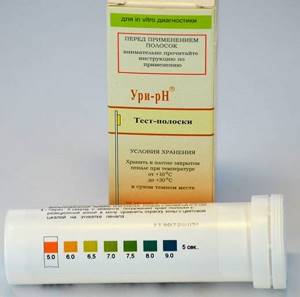
Each package of express analysis contains detailed instructions
Strips for express analysis are coated with a reagent that changes color when reacting with urine. Comparing the color shade obtained on the strip with the color scale on the tube allows you to determine the acidity relative to the normal pH level in urine (5-7 units). When urine becomes acidic, the indicator turns yellow or pink. The lighter the color, the higher the acidity of the urine. Alkalinization changes the color of the indicator from blue-green to blue or dark green.
Reference! The color scale can have several shade options that are close to each other. This feature depends on the test manufacturer.
Analysis by Magarshak method
This is a physical method of chemical analysis based on changing the color of special solutions. A drop of a pre-prepared indicator, consisting of a 0.1% alcohol solution of neutral red and methylene blue solution of similar concentration, is added to the urine. The color of the resulting biofluid indicates the pH level. You can decipher the color indicator using the table:
| Hue | Violet bright | Purple light | Dark gray | Gray-green | Green |
| ≈ value | 6,2 | 6,6 | 6,8 | 7,4 | 7,8 |
Litmus indicator
Litmus paper is a universal indicator for determining the acidic and alkaline conditions in any liquid. The indicator is based on natural dyes azolitmine and erythrolitmine. The pharmacy kit consists of two litmus papers (indicator strips). The method of use is identical to test strips.
Both pieces of paper are placed in a container with urine, after 30 seconds the result is assessed: if both strips remain the original shade, it means the reaction is neutral, redness of the blue strip and the unchanged color of the red indicates acidification, the red strip turned blue and the blue remained unchanged, means alkalization . The disadvantage of the method is the inability to obtain an accurate digital pH value. The Uri-pH biosensor is a more informative method of assessment.
Portable pH meter
A special device designed to assess the acid level in various liquids. The analysis is based on measuring physical potentials in a biofluid by immersing a pair of electrodes in it. The scale of the mechanical device is graduated in pH. The electronic version of the pH meter is equipped with a screen on which a specific digital value is displayed.
There are laboratory and portable instruments. The latter option is suitable for patients who are forced to monitor urine pH daily. The listed methods of self-monitoring of acidity are suitable for both adult patients and children.
Reasons for deviations from the norm
Causes of poor urine analysis
Alkalosis and acidosis are abnormal conditions for the body. This means that there are disturbances in the body due to physiological or pathological reasons. The first category includes:
- irrational physical activity;
- peculiarities of eating behavior (unbalanced diet);
- excessive passion for alcoholic beverages;
- incorrect treatment with certain medications.
In this case, changing your diet and lifestyle will help restore normal pH. An impaired acidity reaction may indicate the development of acute and chronic diseases. However, pathologies are not necessarily associated only with the urinary system.
Acidification of urine
A low pH means the urine is highly acidic. Most often, acidic urine accompanies metabolic disorders, in particular, people with diabetes suffer from this feature. And also a shift of values to the left is observed in the following cases:
- an excess of saturated acids, protein foods and fats in the daily menu (meat, baked goods, butter), as well as a passion for protein diets;
- electrolyte imbalance associated with deficiency of potassium (hypokalemia) and chlorine (hypochloremia);
- inflammation of the bladder walls (cystitis);
- damage to the tubular system of the renal apparatus (pyelonephritis);
- extrapulmonary infection with Koch's bacillus (nephrotuberculosis);
- metabolic disorders (in particular, excessive formation or intake of acids);
- formation of ketone bodies (acetone) in the urine as a complication of diabetes mellitus;
- trauma to the pancreas, with further formation of a pancreatic fistula;
- postoperative syndrome, after ureterosigmoidostomy (surgery on the ureters);
- chronic stool disorder (diarrhea);
- excessive consumption of alcoholic beverages;
- CRF (chronic renal failure);
- inability of the kidneys to remove uric acid (resulting in the development of gout);
- urolithiasis and nephrolithiasis (the presence of urate stones in the organs of the urinary system);
- overdose of calcium and ammonium chloride medications;
- hypervitaminosis of ascorbic acid;
- intoxication of the body;
- adrenal dysfunction.
- intense physical activity (sports training).
A decrease in acidity values can accompany oncohematological diseases and sepsis.
Alkalinization of urine
If the pH is elevated, it means that the urine is predominantly alkaline. A high level of alkali indicates the development of acute conditions, the progression of chronic diseases, and poor nutrition. The following are the causes of alkalinization of urine:
Strips for acetone in urine
- immunoinflammatory damage to the glomeruli of the kidneys (glomeruli), otherwise glomerulonephritis;
- chronic renal failure;
- vegetarianism and veganism, plant-dairy diets with minimal consumption of protein products and fats;
- abuse of table mineral water with a high alkaline content;
- decreased functionality of the adrenal glands to produce hormones (hypocorticism and hypoaldosteronism);
- electrolyte imbalance due to increased potassium concentration (hyperglycemia);
- overactive parathyroid gland (hyperparathyroidism);
- hyperacid gastritis (inflammation of the gastric mucosa, accompanied by increased acidity of gastric juice);
- pyelonephritis and cystitis of bacterial etiology (origin);
- dehydration (dehydration), due to repeated vomiting and diarrhea (symptoms of body intoxication);
- long-term treatment with neurotransmitters (Epinephrine hydrotartrate, Adrenaline);
- incorrect use of nicotinic acid preparations;
- exacerbation of gastric ulcer.
An alkaline reaction can be caused by inflammatory dental diseases, due to a violation of the acid-base balance of the oral cavity. If there are stable deviations in the acid level (regardless of its increase or decrease), it is necessary to examine the kidneys and take a general and biochemical blood test. If pathological changes are not detected, you should adjust your diet, physical activity and give up alcoholic beverages.
Results
Urine pH is a digital indicator of physical and chemical reactions that reflect the state of the acid-base balance in the body. Acidity measurement is carried out during a general urine test and is an important diagnostic criterion. Assessing the pH of urine allows you to timely identify metabolic disorders, possible malfunctions in the kidneys and other organs of the urinary system.
The reference acidity value is from 5 to 7 units. The difference in the values of morning and evening urine does not relate to pathologies, since acid-base reactions largely depend on the foods and drinks consumed. Indicator 5 units. (and below) indicates acidification of urine. Seven or more units as a result of the analysis indicate alkalization.
Both of these conditions are abnormal. If the pH shifts, it is necessary to undergo additional examination to determine the cause of the acid-base imbalance. To independently determine the acidity level of urine, the pharmacological industry produces special rapid tests in the form of strips.
Methods for determining urine pH at home
Urine test strip test
You can independently determine the acidity of urine in several ways:
- Litmus paper;
— Magarshak method;
— Bromothymol blue indicator;
— Visual indicator test strips.
The reagent of litmus paper is a dye based on azolythmine and erythrolythmine. When conducting a study, blue and red litmus paper is immersed in the urine, and the results of the analysis are deciphered by their color. If both papers change color, then the reaction is amphoteric; both papers do not change color - neutral. If the blue paper turns red but the red paper does not change color, the reaction is acidic. When red paper turns blue and blue does not change, an alkaline reaction of urine is observed.
This method allows you to determine in which direction the acidity of the urine has shifted, but in order to find out the exact pH value, liquid indicators are needed.
Determination of urine acidity using the Magarshak method is carried out using an indicator consisting of a mixture of alcohol solutions of neutral red and methylene blue. The approximate pH value of urine is determined by the shade that the urine acquires after adding an indicator to it.
Bromothymol blue indicator is also used to determine the acidity of urine. Examination of urine in this way shows only approximate acidity.
Determining the pH of urine using test strips is a simple and convenient option for home use. The test strip must be dipped into a container of urine, and then compared with a color scale, the colors on which correspond to the pH of the urine.
No method of self-determination of urine acidity can replace laboratory testing in a medical facility.
pH value in urine analysis
The acidity level is determined during a laboratory test of urine or independently, through a special test. The study of acid-base reaction is included in the general urine analysis. The study also evaluates:
- organoleptic properties (volume, color, smell, transparency);
- physico-chemical indicator of density;
- biochemical components (protein, sugar, urobilinogen, leukocytes, etc.).
General analysis is the most accessible and informative method for diagnosing possible abnormalities in the functioning of the body. The results are assessed by comparing the obtained indicators with the reference values accepted in laboratory microscopy. The final protocol (form) is deciphered by the doctor who wrote out the referral for analysis.
For your information! If you monitor your pH yourself, you can ask for help in decoding the results from any therapist in your area of residence.
Each parameter studied has its own units of measurement and standards. pH is measured in units, standards are developed taking into account gender and age. A consistently elevated level of acidity is called acidosis, while deviations in the alkaline direction are called alkalosis.
pH (reaction) of urine
Reference values (or norm) of urine pH (urine reaction): the norm with a normal diet is slightly acidic (pH 5.0 - 7.0). Fluctuations in pH (4.5 - 8.5) depend on the composition of food taken, medications taken, and kidney function. Eating meat causes an acidic reaction, while eating plant foods causes an alkaline reaction in urine.
An increase in pH above normal is called alkalosis, and a decrease is called acidosis. Eating a large amount of plant foods shifts the pH of urine to the alkaline side (pH 7.5), eating meat, on the contrary, shifts it to the acidic side (pH 5 – 5.5),
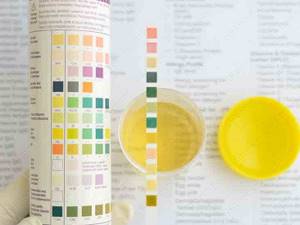
Urine pH
A decrease in pH to 5 (shift to the acidic side) of urine is caused by active physical work, diabetes, fasting, dehydration, fevers, impaired renal function, taking ascorbic acid, methionine.
An increase in pH above 7 occurs when drinking excessive amounts of mineral water, when there is blood in the urine, when the bladder is inflamed, taking adrenaline, bicarbonates.
Establishing the acidity value of urine is extremely important in the treatment of urolithiasis - if the stones are represented by tripelphosphates, then alkaline acidity is extremely undesirable, since it can cause their formation. If the stones are represented by urates, then during treatment it is necessary to maintain the alkaline acidity of the urine to dissolve such stones
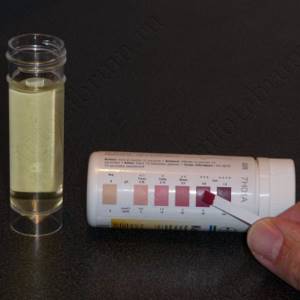
Urine pH determination
- Urine pH is reduced (alkaline reaction) when:
- low protein or plant-based diet
- taking alkalizing medications such as sodium bicarbonate
- respiratory and metabolic alkalosis
- renal tubular acidosis (as a result of disruption of the ability of the proximal tubules to reabsorb bicarbonates, which leads to alkalinization of urine and acidification of the blood)
- chronic urinary tract infections (bacteria break down ammonium)
- Urine pH is increased (acidic) when:
- eating a lot of meat
- taking acidifying medications
- respiratory and metabolic acidosis
- diabetes and ketosis
- fasting, fever
- gout
- potassium deficiency in the body (potassium is reabsorbed in exchange for hydrogen ions, which leads to acidification of urine)
Determining the pH of urine has not only diagnostic value, but also, which is especially important, allows you to more correctly explain its other indicators. For example, the absence of blood cells (erythrocytes, leukocytes) in diseases of the kidneys and urinary tract, occurring with hematuria and leukocyturia, can be explained by the alkaline reaction of urine, in which these elements are quickly destroyed
The reaction of urine affects the activity and reproduction of bacteria, as well as the effectiveness of antibacterial therapy.
Clinical interpretation of urinary pH is only relevant when urinary pH measurements are correlated with other information about the patient's health, or when a diagnosis has been made and urinalysis results indicate the course of a disease.
In other words, urine pH has little clinical significance, but when combined with other symptoms and laboratory values, it can provide important information. The determination of urine pH can be especially indicative against the background of the following pathology: urinary tract infection, renal tubular acidosis, respiratory acidosis, respiratory alkalosis, metabolic acidosis, metabolic alkalosis, drug monitoring, Fanconi syndrome, urolithiasis. The pH ratio of urine and blood in some pathological conditions
| Ph urine | blood ph | Possible pathology |
| Sour | Sour | Diabetes, febrile conditions, fasting, kidney failure, kidney tuberculosis, leukemia, etc. |
| Alkaline | Alkaline | Cystitis, pyelitis, hematuria, after vomiting and diarrhea, during the resorption of exudates and transudates, when taking soda and mineral waters |
| Alkaline | Sour | Hyperchloremic acidosis, renal tubular acidosis, chronic urinary tract infections - bacterial decomposition of nitrogen-containing substances in urine to ammonia |
| Sour | Sour | Hypokalemia, treatment of alkalosis with intravenous infusion of large quantities of NaCl (paradoxical aciduria) |
The influence of urine pH on the processes of stone formation in urolithiasis
Prosyannikov M.Yu., Anokhin N.V., Golovanov S.A., Sivkov A.V., Apolikhin O.I.
Information about authors:
- Prosyannikov M.Yu. – Ph.D., Head. Department of Urolithiasis, Research Institute of Urology and Interventional Radiology named after. ON THE. Lopatkina – branch of the Federal State Budgetary Institution “National Medical Research Center of Radiology” of the Russian Ministry of Health; RSCI AuthorID 791050
- Anokhin N.V. – Candidate of Medical Sciences, Researcher, Department of Urolithiasis, Research Institute of Urology and Interventional Radiology named after. ON THE. Lopatkina – branch of the Federal State Budgetary Institution “National Medical Research Center of Radiology” of the Russian Ministry of Health; RSCI AuthorID 880749
- Golovanov S.A. – Doctor of Medical Sciences, Head. Scientific and laboratory department of the Research Institute of Urology and Interventional Radiology named after. N.A. Lopatkina – branch of the Federal State Budgetary Institution “National Medical Research Center of Radiology” of the Russian Ministry of Health; RSCI AuthorID 636685
- Sivkov A.V. – Candidate of Medical Sciences, Deputy Director for Science, Research Institute of Urology and Interventional Radiology named after. ON THE. Lopatkina – branch of the Federal State Budgetary Institution “National Medical Research Center of Radiology” of the Russian Ministry of Health; RSCI AuthorID 622663
- Apolikhin O.I. – Doctor of Medical Sciences, Professor, Director of the Research Institute of Urology and Interventional Radiology named after. ON THE. Lopatkina – branch of the Federal State Budgetary Institution “National Medical Research Center of Radiology” of the Russian Ministry of Health; RSCI AuthorID 683661
DOI: 10.29188/2222-8543-2020-12-3-72-78
INTRODUCTION
The acidity (pH) of urine is one of the key indicators that allows us to assess the activity of lithogenesis processes in urolithiasis (UCD).
Normal urine pH values can vary widely. This is due to the fact that urine pH is not a rigid physiological constant of the body, such as blood pH. The pH of urine can be classified as a so-called soft or plastic physiological constant, which can deviate from a stable level within a relatively wide range without significant changes in the functioning of the body.
According to modern ideas about the pathogenesis of urolithiasis, changes in urine pH play a key role in the processes of stone formation [1]. Urinary pH indicators specific for the formation of one or another type of urinary stones have been studied and described [2]. The pH values of urine have been determined, which are a risk factor for lithogenesis and, on the contrary, at which the processes of stone formation do not occur or do not occur as intensively.
It is well known that the crystallization of calcium phosphate, uric acid, struvite, and cystine directly depends on the pH of urine [3]. It is known that the risk of uric acid stones increases at a urine pH of 6.5. Struvite stones are formed by urine pH >7.0 [2].
Moreover, changes in urine pH can be associated not only with urolithiasis, but also with other pathological processes, including those occurring in the urinary tract (urothelial cancer, metabolic disorders) [4,5].
Chronic non-infectious diseases are known, which are characterized by changes in urine pH. One of the most common chronic diseases in which a decrease in urine pH is observed is obesity and metabolic syndrome. It has been proven that urine pH values are inversely proportional to body mass index (BMI) in patients with urolithiasis. High BMI increases the risk of developing urolithiasis [6]. It is known that obese patients with a BMI >33.1 kg/m2 have a higher risk of developing uric acid and struvite stones [7].
Some authors believe that in patients suffering from metabolic syndrome and obesity, insulin resistance may act as a pathogenetic basis for disturbed acid-base balance, ultimately leading to urine acidification [8-10]. Studies have demonstrated that insulin resistance can lead to impaired excretion of ammonium ion (NH4+), which, in turn, causes a decrease in urine pH in this group of patients [8-10].
It is known that conditions such as renal tubular acidosis (RTA) and chronic urease-producing urinary tract infection can also lead to changes in urine pH [11, 12].
In addition to pathological processes occurring in the urinary tract, metabolic syndrome, and PCA, changes in urine pH can be caused by a person’s dietary habits. Typically, frequent consumption of foods rich in animal protein and alcohol abuse lead to acidification of urine [13]. High urine pH values are observed when following a vegetarian diet and using alkaline supplements [13].
Thus, urine pH, on the one hand, is one of the significant markers that signal the presence of pathological changes both in the body as a whole and in the urinary system in particular. On the other hand, urine pH remains one of the key parameters regulating the state of the urinary system, determining the type of metabolic lithogenic disorders in KSD.
Considering all of the above, the purpose of this work was to study the influence of urine pH on the formation of urinary stones of various chemical compositions and on the level of excretion in urine of the main stone-forming substances.
MATERIALS AND METHODS
The work was carried out on the basis of the Research Institute of Urology and Interventional Radiology named after. ON THE. Lopatkina is a branch of the Federal State Budgetary Institution “National Medical Research Center of Radiology” of the Russian Ministry of Health.
The study examined data from 708 patients (303 men and 405 women) diagnosed with urolithiasis who received both outpatient and inpatient treatment at the institute. The study was conducted retrospectively.
All patients underwent a biochemical blood test (calcium, sodium, magnesium, phosphorus, chlorine, uric acid, urea, creatinine), a biochemical analysis of 24-hour urine (determination of morning urine pH, calcium, sodium, magnesium, phosphorus, chlorine, uric acid, urea, creatinine), determination of the chemical composition of urinary stones.
Biochemical examination of blood and urine was performed on an ADVIA 1200 analyzer (Bayer-Siemens) according to standard methods using diagnostic reagent kits from Siemens (Germany).
Determination of the chemical composition of urinary stones was carried out by infrared spectroscopy using a Nicolet iS10 spectrometer (Thermo Scientific, USA). During the work, a standard library of spectra of urinary stones provided by the manufacturer was used. The distribution of mixed urinary stones into groups occurred as follows: if the test stone contained more than 50% of a mineral component identical to that declared in the group, the patient’s data was entered into the appropriate group. This approach to classifying types of urinary stones is the most common [14-15].
The search for a statistical relationship between the frequency of occurrence of types of urinary stones and the pH value of urine was performed using the Pearson χ2-square test with the formula entered in Microsoft Excel.
RESULTS
Depending on urine pH, all patients were divided into several groups (Table 1):
- In the first group (pH1), urine pH was 4.8-5.0. This group included data from 111 patients;
- Second group (pH2): the range of urine pH values was 5.1-5.3, data from 71 patients were included;
- Third group (pH3): the range of urine pH values was 5.4-5.5, data from 162 patients were included;
- Group four (pH4): urine pH range 5.6-5.9, data from 74 patients included;
- Fifth group (pH5): urine pH range 6.0-6.1, data from 129 patients included;
- Sixth group (pH6): urine pH range 6.2-6.5, data from 61 patients included;
- Seventh group (pH7): urine pH range 6.6-7.0, data from 57 patients included;
- Eighth group (pH8): urine pH range 7.1-9.0, data from 38 patients included
Table 1. Distribution of types of urinary stones of patients by groups depending on the urine pH (% of the total number of stones in the group) Table 1. Urinary stones types distribution by groups depending on the urine pH (% of the total number of stones in the group)
| Indicator parameters | pH1 | pH2 | pH3 | pH4 | pH5 | pH6 | pH7 | pH8 |
| pH value range pH level | 4,8 — 5,0 | 5,1 — 5,3 | 5,4 — 5,5 | 5,6 — 5,9 | 6,0 — 6,1 | 6,2 — 6,5 | 6,6 — 7,0 | 7,1 — 9,0 |
| All type stones | 111 | 71 | 162 | 74 | 129 | 61 | 57 | 38 |
| CaOX stones (n) # CaOX stones (n) # | 43 | 26 | 73 | 38 | 35 | 23 | 17 | 4 |
| CaOx %* | 38,7 | 36,6 | 45,1 | 51,4 | 27,1 | 37,7 | 29,8 | 10,5 |
| Ur stones (n) # Ur stones (n) # | 47 | 24 | 27 | 10 | 18 | 2 | 7 | 1 |
| Ur %* | 42,3 | 33,8 | 16,7 | 13,5 | 14,0 | 3,3 | 12,3 | 2,6 |
| Dh stones (n) # Dh stones (n) # | 16 | 15 | 42 | 17 | 61 | 31 | 22 | 18 |
| Dh%* | 14,4 | 21,1 | 25,9 | 23,0 | 47,3 | 50,8 | 38,6 | 47,4 |
| OxDh stones (n) # OxDh stones (n) # | 21 | 16 | 46 | 29 | 44 | 10 | 13 | 4 |
| OxDh %* | 18,9 | 22,5 | 28,4 | 39,2 | 34,1 | 32,8 | 22,8 | 10,5 |
| Str stones (n) # Str stones (n) # | 1 | 2 | 8 | 5 | 12 | 3 | 11 | 14 |
| Str %* | 0,9 | 2,8 | 4,9 | 6,8 | 9,3 | 4,9 | 19,3 | 36,8 |
| AmUr stones (n) # AmUr stones (n) # | 1 | 1 | 2 | 0 | 0 | 2 | 0 | 1 |
| AmUr %* | 0,9 | 1,4 | 1,2 | 0 | 0 | 3,3 | 0 | 2,6 |
| Others # Others # | 3 | 3 | 10 | 5 | 3 | 0 | 0 | 0 |
| Others %* Others % | 2,7 | 4,2 | 6,2 | 6,8 | 2,3 | 0 | 0 | 0 |
Note: The predominant component of urinary stones: CaOx - calcium oxalate, Ur - uric acid, Dh - dallit (carbonatapatite), OxDh - calcium oxalate/carbonatapatite, Str - struvite, AmUr - ammonium urate. # is the absolute number of stones of each type in groups рН1-рН8; *—percentage distribution of stones of each type in groups рН1-рН8; Note: The predominant component of urinary stones: CaOx – calcium oxalate, Ur – uric acid, Dh – dallite (carbonatapatite), OxDh – calcium oxalate / carbonatapatite, Str – struvite, AmUr – ammonium urate. # - absolute number of stones of each type in groups рН1-рН8; * — percentage distribution of stones of each type in groups рН1-рН8
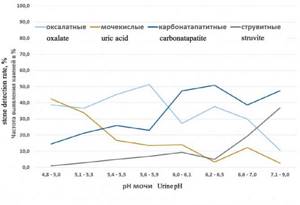
Rice. 1. Frequency of occurrence of the main types of urinary stones (in% of the total) depending on urine pH 1. Frequency of occurrence of the main types of urinary stones (in % of the total amount) depending on urine pH
Analysis of the data obtained showed that the incidence of urinary stones consisting of uric acid decreases as urine pH increases from 42.3% (pH1) to 2.6% (pH8) (p = 0.0000004) (Fig. 1 , table 1).
The results of the study largely coincide with the data presented in other similar works [16,17]. It is believed that low urine pH is one of the main risk factors for the development of uric acid urolithiasis. It is known that when the pH of urine shifts to the acidic side, the solubility of uric acid in urine also decreases [18]. Thus, at a urine pH of 5.35, to obtain a supersaturated solution, it is necessary to achieve a concentration of uric acid in the urine of 200 mg/l. At a urine pH of 6.5, 1200 mg/l of uric acid is required to obtain supersaturated urine [18]. Thus, urine pH is one of the main factors stimulating uric acid lithogenesis.
In addition to low urine pH (<5.6), a significant risk factor for the development of uric acid urolithiasis is a high level of uric acid excretion in the urine. Analysis of the data obtained showed that the level of uric acid excretion in the ranges pH1 – pH4 increased from 3.256 mmol/day to 3.814 mmol/day, in the ranges pH4 – pH8 decreased from 3.814 mmol/day to 2.826 mmol/day (Table 2, Fig. 2). The maximum level of uric acid excretion in urine was recorded in the urine pH range of 5.6-5.9 (pH4) and amounted to 3.814 mmol/day (Table 2, Fig. 2).
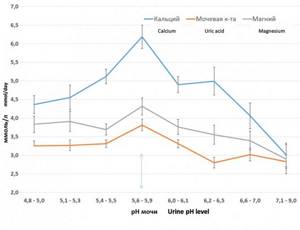
Rice. Fig. 2. Average values of excretion rates (mmol/day) of magnesium, phosphates, calcium and uric acid in ranked ranges of urine pH values Fig.2. Average values of magnesium, phosphates, calcium and uric acid excretion depending on urine pH level
Table 2. Distribution of average values of excretion rates of the main lithogenic substances depending on the urine pH Table 2. The main lithogenic substances excretion level depending on the urine pH
| Indicator parameters | pH1 | pH2 | pH3 | pH4 | pH5 | pH6 | pH7 | pH8 |
| pH value range pH level | 4,8 — 5,0 | 5,1 — 5,3 | 5,4 — 5,5 | 5,6 — 5,9 | 6,0 — 6,1 | 6,2 — 6,5 | 6,6 — 7,0 | 7,1 — 9,0 |
| All type stones (total n=708) | 111 | 71 | 162 | 74 | 129 | 61 | 57 | 38 |
| Calcium excretion at intervals cf. Calcium excretion meaning | 4,365 | 4,554 | 5,1185 | 6,184 | 4,897 | 4,992 | 4,06 | 3,01 |
| Standard error of the mean (SE) | 0,237 | 0,329 | 0,197 | 0,316 | 0,216 | 0,375 | 0,347 | 0,317 |
| Excretion of uric acid at intervals cf. Uric acid excretion meaning | 3,256 | 3,268 | 3,314 | 3,814 | 3,310 | 2,802 | 3,020 | 2,826 |
| Standard error of the mean (SE) | 0,126 | 0,145 | 0,103 | 0,155 | 0,109 | 0,142 | 0,169 | 0,175 |
| Phosphate excretion at intervals cf. Phosphate excretion meaning | 27,703 | 25,787 | 26,349 | 29,149 | 24,911 | 23,931 | 24,658 | 19,203 |
| Standard error of the mean (SE) | 1,129 | 1,346 | 0,823 | 1,357 | 0,909 | 1,441 | 1,420 | 1,546 |
| Excretion of magnesium in intervals cf. Magnesium excretion meaning | 3,832 | 3,908 | 3,693 | 4,316 | 3,762 | 3,553 | 3,393 | 2,896 |
| Standard error of the mean (SE) | 0,217 | 0,273 | 0,149 | 0,231 | 0,199 | 0,254 | 0,254 | 0,392 |
Thus, monitoring urine pH levels and maintaining urine pH at a level >5.9 is one of the main methods for preventing relapse of uric acid urolithiasis.
The frequency of occurrence of calcium oxalate stones increased in the pH ranges of 5.1 (pH2) – 5.9 (pH4) and 6.1 (pH5) – 6.5 (pH6) (Table 1, Fig. 1). At the same time, in the pH ranges of 5.6 (pH4) – 6.1 (pH5) and 6.5 (pH6) – 9.0 (pH8), a sharp decrease in the incidence of calcium oxalate urinary stones was recorded (Table 1, Fig. 1).
There is an opinion that both local and systemic acidosis can stimulate calcium oxalate lithogenesis. Acidosis suppresses the expression and activity of the calcium channel TRPV5, which is localized at the end of the distal convoluted tubule [20]. At the same time, acidosis increases the expression of the calcium-binding protein calbindin 28k [21]. Thus, local and systemic acidosis can stimulate urinary excretion of calcium and phosphorus and thereby increase the risk of calcium oxalate urinary stones.
The data obtained in this study partially confirm the results of previous works: the analysis showed that the highest levels of calciuria were observed at urine pH 5.4 (pH3) – 6.1 (pH5) (Table 2, Fig. 2). The maximum level of calcium excretion in urine was recorded at a urine pH of 5.6-5.9 (pH4).
Thus, acidosis stimulates an increase in the level of calcium excretion in the urine. However, at the same time, it must be emphasized that the highest level of calciuria (6.184 mmol/day) was recorded with a moderate shift in urine pH to the acidic side (5.4-6.1), while with sharply acidic urine (pH urine <5.0), calcium excretion rates were low - 4.365 mmol/day, the same as with urine pH 6.6-7.0 (pH7) (4.06 mmol/day). Accordingly, a risk factor for the formation of oxalate stones is a urine pH of 5.6-5.9. It is at these urine pH levels that the highest level of calciuria and the highest incidence of calcium oxalate urinary stones are observed.
This study also showed that the prevalence of carbonataptite urinary stones increased with increasing urine pH. This trend can be seen especially clearly in the urine pH range 5.6 (pH4) – 6.5 (pH6): the prevalence of carbonate apatite stones increased from 23.0% to 50.8% (Table 1, Fig. 1) (p= 0.00003). The maximum incidence of carbonate apatite stones was recorded at urine pH levels of 6.2-6.5 and amounted to 50.8%.
The increase in the prevalence of carbonate apatite stones with increasing urine pH values is understandable. Previous work has shown that the solubility of calcium phosphate significantly depends on urine pH: at urine pH <6.2, the solubility of calcium phosphate salts significantly improves, which, accordingly, reduces the likelihood of lithogenesis [21].
According to the data obtained in this work, the highest level of phosphaturia (29.149 mmol/day), as well as the highest levels of calciuria, were observed at urine pH levels of 5.6-5.9 (pH4).
Although the maximum level of urinary excretion of both calcium and phosphorus was recorded at a urine pH of 5.6-5.9, the maximum incidence of carbonate apatite stones was recorded at a urine pH of 6.0-6.5. It is likely that in urolithiasis with calcium phosphate stones, the level of concentration of stone-forming substances in the urine is secondary. The pH level of urine has a greater influence on lithogenesis, as it affects the solubility of calcium phosphate salts. Accordingly, when carrying out preventive measures to prevent recurrent stone formation, it is necessary to control urine pH at a level of <5.9.
The study demonstrated that a sharp increase in the incidence of struvite stones is observed in the urine pH range of 6.6 (pH7) – 9.0 (pH8) (Table 1, Fig. 1) (p = 0.00004). The data obtained are comparable with generally accepted ideas about the lithogenesis of struvite stones [2].
CONCLUSIONS
Urinary pH is one of the main factors influencing lithogenesis in KSD. The data obtained allowed us to conclude that in the metaphylaxis of oxalate urolithiasis it is necessary to maintain urine pH at values >5.9, for phosphate (carbonate apatite) urolithiasis at 5.9, for struvite stones <6.6.
LITERATURE
- Wagner CA, Mohebbi N. Urinary pH and stone formation. J Nephrol 2010;23 Suppl 16:S165-9.
- Türk C, Skolarikos A, Neisius A, Petřík A, Seitz C, Thomas K. URL Türk, C. Guidelines on Urolithiasis. European Urology Association 2021. URL: https://uroweb.org/guideline/urolithiasis/
- John R. Asplin Metabolic Evaluation: Interpretation of 24-Hour Urine Chemistries. In book Urinary Stones. Medical and Surgical Management Willey. 2014, p. 21
- Ide H, Kikuchi E, Hagiwara M, Hayakawa N, Hongo H, Miyajima A, Oya M. Urinary pH levels are strongly associated with bladder recurrence after nephroureterectomy in upper tract urothelial carcinoma patients with a smoking history. Ann Surg Oncol 2016;23:1029–1038. doi: 10.1245/ s10434-016-5555-y.
- Bihl G, Meyers A. Recurrent renal stone disease-advances in pathogenesis and clinical management. Lancet 2001;358:651–656. doi: 10.1016/ S0140-6736(01)05782-8.
- Li WM, Chou YH, Li CC, Liu CC, Huang SP, Wu WJ, et al. Association of body mass index and urine pH in patients with urolithiasis. Urol Res 2009;37(4):193-6. doi:10.1007/s00240-009-0194-4.
- Golovanov S.A., Sivkov A.V., Anokhin N.V., Drozhzheva V.V. Body mass index and chemical composition of stones. Experimental and Clinical Urology 2015;(4):94-99.
- Gusakova D.A., Kalinchenko S.Yu., Tyuzikov I.A. Basics of hormonal-metabolic therapy of urolithiasis. Effective Pharmacotherapy 2018;(2):32-39.
- Abate N, Chandalia M, Cabo-Chan AV Jr, Moe OW, Sakhaee K. The metabolic syndrome and uric acid nephrolithiasis: novel features of renal manifestation of insulin resistance. Kidney Int 2004;65(2):386-92. doi: 10.1111/j.1523-1755.2004.00386.x.PMID: 14717908
- Maalouf NM, Cameron MA, Moe OW, Adams-Huet B, Sakhaee K. Low urine pH: a novel feature of the metabolic syndrome. Clin J Am Soc Nephrol 2007;2(5):883-8. doi: 10.2215/CJN.00670207.
- Santos F, Gil-Peña H, Alvarez-Alvarez S. Renal tubular acidosis. Curr Opin Pediatr 2017; 29(2):206-210. doi: 10.1097/MOP.0000000000000460
- Das P, Gupta G, Velu V, Awasthi R, Dua K, Malipeddi H. Formation of struvite urinary stones and approaches towards the inhibition- a review. Biomed Pharmacother 2017;96:361-370. doi: 10.1016/j.biopha.2017.10.015.
- Prezioso D, Strazzullo P, Lotti T, Bianchi G, Borghi L, Caione P, et al. Dietary treatment of urinary risk factors for renal stone formation. A review of the CLU Working Group. Arch Ital Urol Androl 2015;87(2):105-20. doi: 10.4081/aiua.2015.2.105
- Cho ST, Jung SI, Myung SC, Kim TH. Correlation of metabolic syndrome with urinary stone composition. Int J Urol 2013;20(2):208-13. doi: 10.1111/j.1442-2042.2012.03131.x.
- Rendina D, De Filippo G, De Pascale F, Zampa G, Muscariello R, De Palma D, et al. The changing profile of patients with calcium nephrolithiasis and the ascendancy of overweight and obesity: a comparison of two patient series observed 25 years apart. Nephrol Dial Transplant 2013;28 Suppl 4:iv146-51. doi: 10.1093/ndt/gft076.
- Pazos Pérez F. Uric Acid Renal Lithiasis: New Concepts. Contrib Nephrol 2018;192:116-124. doi: 10.1159/000484286.
- Stansbridge EM, Griffin DG, Walker V. Who makes uric acid stones and why - observations from a renal stones clinic. J Clin Pathol 2013;66(5):426-31. doi: 10.1136/jclinpath-2012-201373.
- Koka RM, Huang E, Lieske JC. Adhesion of uric acid crystals to the surface of renal epithelial cells. Am J Physiol Renal Physiol 2000;278(6):F989-98. doi: 10.1152/ajprenal.2000.278.6.F989.
- Nijenhuis T, Renkema KY, Hoenderop JG, Bindels RJ. Acid-base status determines the renal expression of Ca2+ and Mg2+ transport proteins. J Am Soc Nephrol 2006;17(3):617-26. doi: 10.1681/ASN.2005070732.
- Rizzo M, Capasso G, Bleich M, Pica A, Grimaldi D, Bindels RJ, Greger R. Effect of chronic metabolic acidosis on calbindin expression along the rat distal tubule. J Am Soc Nephrol 2000;11(2):203-10.
- Nancollas GH. Phase transformation during precipitation of calcium salts. In: Biological mineralization and demineralization (Dahlem workshop). Springer, Berlin Heidelberg New York, 1982. P. 79-99

Topics and tags
Urolithiasis disease
Magazine
Journal "Experimental and Clinical Urology" Issue No. 3 for 2020
Comments
To post comments you must log in or register
Reasons for changes in urine acidity
Most metabolic products are excreted from the body through the kidneys, so you need to understand that acidity is due to the influence of many factors.
By and large, acidity is a dynamic value that differs from person to person and even changes from one person to another depending on the food consumed, medications taken, lifestyle or time of day. A change in the pH of urinary sediment can occur towards acidification or towards alkalization.
Acidification
Urine acidification is a condition in which the pH becomes less than 5.0. This may occur due to a change in diet, increased physical activity, or pathology of the urinary system.
There are a huge number of diseases that contribute to changes in the acidity of urine. Basically, the pH drops to 5 in diabetes. An acidic urine reaction occurs under the following conditions:
- metabolic acidosis;
- Diabetes mellitus is characterized by a significant change in the composition of urine, not only in terms of a decrease in acidity, but also in the form of an increase in the amount of glucose;
- fever;
- Gout is a common rheumatological disease, the characteristic symptom of which is the acidic environment of urine. The disease is caused by a violation of purine metabolism, as a result of which a large amount of uric acid begins to accumulate in the body;
- leukemia;
- eating low carbohydrate foods;
- An increase in urine acidity may be caused by drugs that increase diuresis. This means that such medications are only allowed to be taken in short courses;
- infectious diseases of the urinary system caused by Escherichia coli or mycobacteria;
- chronic renal failure;
- eating foods high in protein. In addition to meat, acid-boosting foods include white bread, fish and cheese;
- sepsis;
- treatment with ascorbic acid in a dosage of more than 2 g per day significantly increases the pH of urine and also increases the risk of developing urolithiasis;
- pathologies of the digestive system.
When urine acidity is elevated for more than 10 days, this is an important laboratory indicator indicating a metabolic disorder or a decrease in the filtration function of the glomerular apparatus of the kidneys.
Also, a slight decrease in the pH level of urinary sediment occurs in newborns. Acidic urine in a newborn is completely physiological and should not cause concern to parents. As the child gets older, the acidity of the urine will level out.
Alkalinization
Alkalinization of urine is a condition in which the pH level becomes more than 7. Alkalinity in the urine can be detected with regular consumption of lactic acid or plant products, as well as with bacterial and metabolic diseases. The reasons for such deviations may be the following factors:
- chronic bacterial urinary tract infection. Microbes are able to ferment nitrogen-containing compounds to ammonia, which leads to an increase in pH;
- hyperkalemia;
- adrenal hormone deficiency;
- renal tubular acidosis;
- metabolic and respiratory alkalosis;
- passing bloody urine (hematuria);
- increased levels of phosphate-containing compounds in the urine;
- drinking large amounts of mineral water;
- a diet containing large amounts of plant foods, black bread, milk;
- inflammation of the walls of the urinary tract (cystitis, urethritis);
- postoperative period.
In severe pathological processes, chronic renal failure often occurs, leading to alkalization of urine. This is caused by both congenital (primarily wrinkled kidney, pathology of the renal vessels) and acquired (glomerulonephritis, pyelonephritis, diabetic kidney) causes.
Also, temporary alkalization of urine can be caused by intravenous administration of a solution of buffered soda. It is administered in emergency cases accompanied by significant acidification of the blood (sepsis, liver failure, ketoacidotic coma).
Clinically, an increase in pH levels is manifested by general weakness, diffuse headache, nausea and vomiting.
Rules for collecting urine for analysis
To obtain reliable data, the patient must know how to properly collect urine for general analysis.
- On the eve of urine collection, you should not eat fatty, spicy, fried, or sweet foods. If there are a lot of products, they will affect the result.
- You should not take new medications for 3-4 days. The exception is drugs that affect a woman’s life and health. But the attending physician and laboratory assistant are warned about them.
- Immediately after waking up in the morning, they begin to collect urine, but before that you should not eat food or drink large amounts of water.
- Urine is collected in a sterile container, which is purchased at a pharmacy. Cans, bottles and other contaminated containers should not be used. Even if you clean and disinfect them yourself, foreign substances will remain inside. They influence the data obtained.
- Before emptying the bladder, close the vaginal opening with a cotton swab. This is necessary so that foreign bacteria and pregnancy discharge do not get into the sample.
- For a general clinical examination of urine, the first portion of liquid is flushed down the toilet, and the middle portion is collected in a container. After collection, the container is closed with a lid.
- The urine sample is immediately taken to the laboratory. But there are times when it can be collected early in the morning when the clinic is closed. Then the liquid is placed on the door of the refrigerator. Do not place it in the freezer or the coldest parts of the refrigerator. The sample is left in the cold for no more than 2-3 hours. After this time, uncontrolled biochemical processes will begin that change the result.
As the uterus grows, the condition of the internal organs changes. The liver, kidneys, and digestive tract are compressed. Therefore, clinical tests are constantly taken during pregnancy in order to promptly identify abnormalities.
What is acidification and alkalization of the body, blood, urine: signs and symptoms
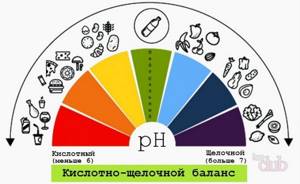
What is acidification and alkalization of the body, blood, urine: signs and symptoms Danger to the body is posed by acidic foods that we are accustomed to consuming without paying attention to the norm. Few people know how harmful these products are to our health. So, what is acidification and alkalization of the body, blood, urine?
- The blood of a healthy person has a slightly alkaline reaction: 7.35-7.45. If your blood test results are higher, this is a disease; lower, too.
- Most people suffer precisely from acidification of the body - acidosis.
- It is easy for a raw foodist with alkalosis to be cured by adding acidic foods to the menu, but for a meat eater with acidosis it is much more difficult to recover.
Signs and symptoms if acidity increases greatly:
- Immunity decreases - a person begins to get colds often.
- Bones become brittle - the body uses a lot of calcium to alkalize.
- The activity of good enzymes decreases - you feel lethargic and constant fatigue.
- The body retains water - the limbs, face, or whole body swell.
The body does not like excessive oxidative processes, and it responds by refusing to function in specific organs and systems. A lot of effort is spent on processing acidic products. The more you use them, the more energy you use. Nutrients such as calcium, potassium, sodium and iron are consumed.
Properties of urine
Urine is a yellow physiological fluid that is formed during the life of the body. Its main function is the removal of metabolic products, regulation of osmotic pressure and ionic composition of the blood. During the day, 800–1500 cm³ of urine is released, this is the norm for a healthy person. With the development of any diseases, indicators may change up or down. Diuresis depends on a person’s physical activity, ambient temperature, body weight, and humidity.
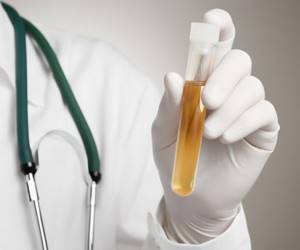
Urine is produced in the kidneys while filtering blood. The tubules regulate the absorption and excretion of ions, then the fluid flows through the ureters into the cavity of the bladder and is excreted through the urethra. In healthy people, urine has a light yellow color; when red blood cells, cholesterol and other pathological components appear, its shade changes, a sediment forms, and an unpleasant odor appears.
Urine consists of more than 90% water, the rest is salts and breakdown products of protein compounds. With the development of diseases, impurities of sugar, blood, ketone bodies, protein, leukocytes, oxalic salts, lactic acid, and red blood cells may be found in the urine. Electrolytes are released along with urine: calcium, sodium, potassium, magnesium, sulfates, as well as hormones, enzymes and vitamins.
Preparing to test urine for an acidic environment
The most objective indicators are obtained by examining morning urine.
Before collecting it, it is necessary to carry out hygiene procedures for the genitals. It is better to submit urine for analysis in sterile containers purchased at a pharmacy no later than 2 hours after collection. If the shelf life is longer, alkalization or an increase in acidity may occur.
Urine should be delivered to the laboratory at a temperature of at least 10 °C. At lower temperatures, a precipitate forms, making research difficult.
Before submitting urine for analysis, it is not recommended to:
- Take medications and food at least 8 hours before the test.
- Physical exercise.
- Eating fried, smoked, pickled foods.
- Drinking alcohol, coffee, or foods containing pigment that affects the color of urine.
How is urine pH determined in the laboratory?
A general urine test evaluates not only the characteristics of the fluid, but also the composition of the sediment. The doctor is obliged to prescribe a test to diagnose the provoking change in the composition of urine, and also again after recovery from an infectious disease.
The PH of urine will show endocrine disorders, the presence of sand and stones in the kidneys. Low urine acidity (below 5.5) causes the formation of uric acid stones. A urine pH of 5.5-6.0 is fraught with the appearance of oxalate formations, and more than 7 - phosphate kidney stones. A laboratory method such as titration gives a more accurate acidity result.
Preparatory measures and rules for collecting urine are of great importance for the accuracy of the result. For an accurate value, you need an average portion of urine, which is collected in the morning on an empty stomach. Be sure to wash the external genitalia thoroughly before collection. The biomaterial is collected in a cleaned glass container or plastic container, which must be delivered to the laboratory within the next few hours.
Two or three days before the urine test, you should not drink alcoholic beverages, herbal teas, or medications, especially diuretics. It is not recommended to submit urine for testing during menstruation. A day before the urine test, brightly colored fruits and vegetables are excluded from the diet.
Acidic urine pH
Acidic urine can create an environment in which kidney stones can form.
If a person has a low urine pH, it means the urine is acidic and indicates a health condition such as:
- diabetic ketoacidosis, which is a complication of diabetes;
- starvation.
Taking certain medications can make a person's urine pH alkaline or acidic.
Because many factors affect urine pH, a doctor cannot diagnose a disease based on pH alone. For example, a pH above 7 may signal a UTI or other type of infection. A doctor may test urine pH along with other symptoms to make a diagnosis.
Drugs such as carbonic anhydrase inhibitors (acetazolamide) work to make urine alkaline, so your doctor may take more than one sample to see if the pH is changing.
Normal values
The acidity of urine is determined by the following features:
- age category of the patient (adults and children);
- gender (women and men);
- time of day (morning and evening);
- nutritional characteristics (predominance of protein, plant or dairy products in the diet);
- the presence of chronic diseases (endocrine, urinary system, gastrointestinal tract).
In women, the acid-base balance is affected by pregnancy and breastfeeding. Normal pH levels range from 5 to 7 units. According to accepted laboratory standards, slightly acidic urine is considered healthy. The optimal value in this case is pH 6.
Children's indicators
In an infant, the acidity of urine depends on the feeding habits (artificial formula or natural feeding), as well as on the time of birth relative to the duration of pregnancy (term or premature).
| Babies born at term | Premature babies | Artificials | Breastfed babies |
| from 5.4 to 5.9 units. | from 4.8 to 5.4 units. | from 5.4 to 6.9 units. | from 5.6 to 6.0 units. |
Unstable pH in a newborn baby does not cause concern, provided that there are no genetic pathologies or congenital developmental abnormalities. Normalization of the level occurs on days 3–4. In children and adolescents up to adulthood, the normal pH of urine falls within the range of 6.5 to 7.5 units.
Level in adult men and women
The acidity level in adult men is affected by muscle mass (MM); in women, it is influenced by the perinatal period and lactation. During pregnancy, a slight excess of reference values is allowed.
| Men | Women | |||
| average MM | high MM | not pregnant | pregnant women | nursing |
| 6,3–6,5 | 6,5–7,2 | 6,0–6,5 | 5,0–8,0 | 6,5–6,8 |
Deviations of a short-term nature are observed at night and in the morning (before breakfast). The pH level can drop to 5.2 units. in the morning, and increase in the evening to 7 units. Such “swings” do not pose any danger. A constant acidity value in the morning and evening, which does not go beyond the normative limits, does not apply to pathologies. If during the day the reaction remains stably acidic or stably alkaline, there is a need for additional examination.
Additionally
Acidification of urine (acidosis) occurs at pH levels of 5 and below. Uric acid, salts of phosphoric and oxalic acids interact with liquids in which the acidity level is normal or slightly elevated. When the pH decreases to 5 units or less, they turn into sediment.
A consistently high level of acidity provokes the formation of uric acid urate stones with a soft structure. In people of reproductive age, the location of stones is usually the kidneys and ureter; in elderly patients and children, urolithiasis (urolithiasis) affects the bladder. In addition, acidified microflora is a favorable environment for the proliferation of pathogens.
Escherichia coli is usually the most active. Escherichia coli is a gram-negative bacterium that can cause not only severe poisoning. Excessive spread of E. coli can provoke: inflammation of the meninges (meningitis), pneumonia, hemolytic-uremic syndrome, systemic blood infection (sepsis).
Alkalosis (alkalization of urine) corresponds to values exceeding pH 7. In this case, there is a high probability of the formation of phosphates (alkaline stones) in the renal pelvis and calyces. A feature of stones of phosphate origin is their accelerated growth. If the diagnosis is not made in a timely manner, the only way to get rid of phosphates is through surgery.
An alkaline environment inhibits the body's immune functions, which promotes the penetration and rapid development of bacterial infections of the bladder and kidneys. pH values of 8 and higher are recorded for bacteriuria (the presence of bacteria in the urine). The most dangerous infections include varieties of Streptococcus (staphylococcus):
- Staphylococcus aureus – Staphylococcus aureus;
- Staphylococcus epidermidis – epidermal staphylococcus;
- Staphylococcus saprophyticus is a saprophytic staphylococcus.
Colonization of staphylococcal microorganisms in the urine leads to the development of bacterial cystitis and bacterial pyelonephritis.
the acid-base balance is normal or (acid-base indicator) of any necessary liquid and mixtures of liquids, such as the environment of the human body (urine, saliva, feces, semen, vaginal environment , breast milk) and external media (solutions, water, drinks, etc.).
Why you need to know this
The fact is that, starting from the 90s of the 20th century, speculation about the compliance of any product, according to the pH indicator, with the human body has become a very common phenomenon: we are told about this from soap advertising to advice on which muesli to choose for breakfast.
Although for most people, to be honest, this indicator does not mean anything, since most do not remember either the school course in chemistry or biology, and modern schoolchildren are simply not told about this. So manufacturers take advantage of general illiteracy, introducing into consciousness the usefulness of their products through the use of scientific information.
But is it really that simple?
Not really. The fact is that all human environments: urine, saliva, feces, semen, vaginal lubrication, breast milk, etc. – have different acidity-alkalinity indicators.
Moreover, if we take the entire gastrointestinal tract, which begins in the oral cavity and ends in the rectum, it has different pH in its sections. This means that the equation of the entire organism to a single pH value can lead to illness and death ! This is why pH is also called acid-base EQUILIBRIUM.

What is pH
The ratio of acid and alkali in any solution is called acid-base balance (ABC), although physiologists believe that it is more correct to call this ratio the acid-base state.
KSHR is characterized by a special pH indicator (power Hidrogen - “hydrogen power”), which shows the number of hydrogen atoms in a given solution. At a pH of 7.0 they speak of a neutral environment. The lower the pH level, the more acidic the environment (from 6.9 to 0). An alkaline environment has a high pH level (from 7.1 to 14.0).
The human body is 80% water , so water is one of its most important components. The human body has a certain acid-base ratio, characterized by pH (hydrogen) value.
The pH value depends on the ratio between positively charged ions (forming an acidic environment) and negatively charged ions (forming an alkaline environment).
The human body constantly strives to balance this ratio, maintaining a strictly defined pH level. When the balance is disturbed, many serious diseases can occur.
pH, or indicator of acid-base balance
It is a measure of the relative concentration of hydrogen (H+) and hydroxyl (OH–) ions in a liquid system and is expressed on a scale from 0 (complete saturation with hydrogen ions H+) to 14 (complete saturation with hydroxyl ions OH–), distilled water is considered neutral with pH 7.0.
An increase in the concentration of positive hydrogen ions (H+) in any body fluid causes a shift in pH values towards zero and is called an acid shift. An increase in the concentration of hydroxyl ions OH causes a shift in pH values towards 14 and is called an alkaline shift.
A very long time ago, substances were discovered in chemistry that have the ability to change their color in the presence of acids and alkalis. These substances are called indicators and are used to determine the reaction medium.
The environment can be acidic, alkaline and neutral. It is thanks to them that in modern medicine it is possible to saturate filter paper with litmus. Litmus is a coloring substance extracted from certain types of lichen, actually a weak acid. Its composition is complex.
How to use indicator paper:
It is necessary to dip a strip of paper into the required solution for two to three seconds. Compare with the supplied color chart and calculate the values.
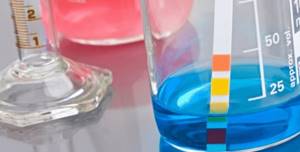
pH STANDARDS
Solutions and liquids with respect to their acidity are considered:
- neutral at pH = 7
- acidic at pH < 7 alkaline at pH > 7
You can measure the acidity of any liquid medium. It is important for us to know and understand the state of our body. But remember that healthy acidity differs in different environments of the body.
Acid-base balance. Acidity of urine
If the urine pH level fluctuates between 6.0 - 6.4 in the morning and 6.4 - 7.0 in the evenings, then the body is functioning normally. The most optimal level: slightly sour, in the range of 6.4 – 6.5. A urine pH value below 5.0 indicates that it is strongly acidified, and above 7.5 indicates that it is strongly alkaline.
The reaction of urine determines the possibility of stone formation : urate - in an acidic environment, oxalate - in a neutral-acidic environment, phosphate - in a more alkaline environment.
For example, uric acid stones virtually never occur when the urine pH is greater than 5.5, and phosphate stones never form unless the urine is alkaline. The best time to determine the pH level is 1 hour before or 2 hours after a meal .
Check the pH level twice a week 2-3 times a day.
Using indicator litmus paper pH test, you can easily, quickly and accurately monitor the response of urine to changes in the type of diet, the use of medications or dietary supplements.
Positive pH dynamics can serve as a criterion for the correctness of the chosen diet or treatment. The acidity of urine varies greatly depending on the food taken, for example, eating plant foods increases the alkaline reaction of urine. The acidity of urine increases if a person’s diet is dominated by meat foods rich in proteins.
Heavy physical work increases the acidity of urine.
Increased acidity of urine is observed with increased acidity of the stomach. Reduced acidity of gastric juice does not affect the acidity of urine.
The acidity of urine changes in many diseases or conditions of the body, so determining its acidity is an important diagnostic factor.
The “Organ Star” cleansing system will help bring the body into a healthy state.

Acid-base balance. Saliva acidity
The acidity of saliva depends on the rate of salivation. Typically, the acidity of mixed human saliva is 6.8–7.4 pH, but with high salivation rates it reaches 7.8 pH. The acidity of the saliva of the parotid glands is 5.81 pH, of the submandibular glands - 6.39 pH. In children, the average acidity of mixed saliva is 7.32 pH.
Optimal measurement from 10 to 12 hours. It is better to measure it on an empty stomach, two hours before or two hours after a meal. Salivation decreases in the evening and at night.
To increase salivation, in order to increase the pH of saliva, it is good if there is a piece of lemon on the plate; it even with visual perception increases salivation.
Food should look appetizing, served on beautiful dishes, appetizingly decorated with herbs and/or vegetables, it should, as they say, please the eye! Not only the saliva flows, but also the juices in the body, preparing for the process of digesting food. This is the mental phase of digestive secretion.

Saliva, which normally has alkaline properties, at low pH, especially at values of 6.2–6.0, leads to focal demineralization of tooth enamel with the appearance of erosions of hard dental tissues and the formation of cavities in them - caries. The amount of mucus on the mucous membrane increases, the gums become swollen and inflamed.
When the acidity in the oral cavity decreases, the acidity of dental plaque decreases, which causes the development of caries.
Bacteria in the mouth thrive in the absence of air. Saliva, rich in oxygen, actively prevents their reproduction. Bad breath occurs when the flow of saliva slows down, such as during sleep.
Excitement, hunger, pronouncing a long monologue, breathing through the mouth (for example, with a runny nose), stress - dry out the oral cavity, leading to a decrease in the pH of saliva. A decrease in saliva flow inevitably occurs with age.
You can set the desired pH of water for rinsing or ingestion using litmus indicator paper. There cannot be recipes with the required proportions, because... Each region has its own water, with its own pH. Therefore, it is necessary to have indicator paper on hand.
Acid-base balance. Vaginal acidity
The normal acidity of a woman's vagina ranges from 3.8 to 4.4 pH and averages 4.0 to 4.2 pH.
Vaginal acidity in various diseases:
- cytolytic vaginosis: acidity less than 4.0 pH
- normal microflora: acidity from 4.0 to 4.5 pH
- candidal vaginitis: acidity from 4.0 to 4.5 pH
- Trichomonas colpitis: acidity from 5.0 to 6.0 pH
- bacterial vaginosis: acidity greater than 4.5 pH
- atrophic vaginitis: acidity greater than 6.0 pH
- aerobic vaginitis: acidity greater than 6.5 pH
Lactobacilli (lactobacillus) and, to a lesser extent, other representatives of normal microflora are responsible for maintaining an acidic environment and suppressing the growth of opportunistic microorganisms in the vagina. In the treatment of many gynecological diseases, restoration of the lactobacilli population and normal acidity comes to the fore.
Read also: How to properly maintain feminine hygiene.
Acid-base balance. Sperm acidity
The normal acidity level of sperm is between 7.2 and 8.0 pH. Deviations from these values are not in themselves considered pathology. At the same time, in combination with other deviations, it may indicate the presence of a disease.
An increase in the pH level of sperm occurs during an infectious process. A sharply alkaline reaction of sperm (acidity approximately 9.0–10.0 pH) indicates prostate pathology.
When the excretory ducts of both seminal vesicles are blocked, an acidic reaction of the sperm is observed (acidity 6.0–6.8 pH).
The fertilizing ability of such sperm is reduced. In an acidic environment, sperm lose motility and die. If the acidity of the seminal fluid becomes less than 6.0 pH, the sperm completely lose their motility and die.
Read also: How to maintain and restore men's health.
The acidity of tears is normal - from 7.3 to 7.5 pH.
The acidity of feces is normally from 6.0 to 8.0 pH.
The acidity of human breast milk is 6.9-7.5 pH
Acid-base balance. Blood acidity
(here you will need special strips with a narrower and more detailed measurement range) The acidity of human arterial blood plasma ranges from 7.37 to 7.43 pH, averaging 7.4 pH.
The acid-base balance in human blood is one of the most stable parameters, maintaining acidic and alkaline components in a certain balance within very narrow limits.
Even a small shift from these limits can lead to severe pathology. When shifting to the acidic side, a condition called acidosis occurs, and to the alkaline side, alkolosis occurs. A change in blood acidity above 7.8 pH or below 6.8 pH is incompatible with life.
The acidity of red blood cells is 7.28–7.29 pH.
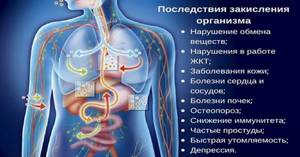
Normal blood revitalizes lymph cells that can destroy tumor cells. There are many lymphatic cells (eg NK cells, LAK cells) in the human body.
Their uniqueness lies in the fact that they are able to distinguish normal cells from diseased and damaged ones, and destroy the latter. This is the function of the human body's immunity . The greatest activity of lymphatic cells in destroying diseased cells occurs at pH 7.4.
However, usually around the affected cells, there is a more acidic environment, which interferes with the activity of lymphocytes, which work better at a slightly alkaline pH. By consuming foods that have an alkalizing effect, you can adjust the pH balance within 0.5 units, creating a favorable environment for the action of lymphocytes and the destruction of affected or abnormally constructed cells.
Cancerous tissue has increased acidity, unlike normal tissue, and the body protects it with a fibrous membrane, which has an alkaline pH. If you continue to follow the acidic diet, the membrane dissolves and the cancer cells are released.
Once a week, when the body is acidified, it is advisable to arrange treatment days for yourself , eating only vegetables (1.5 kg of vegetables, divided throughout the day), boiled and sometimes raw in the summer, only heat-treated in the autumn-winter) and Be sure to have clean hot water.
In addition, remember that a violation of the pH of the body’s environment leads not only to the development of diseases, slagging of the body, but also to hormonal changes, which affects a person’s metabolism, his mood, and character.
A person’s mood is also important for maintaining a normal pH level in the body; a good, cheerful mood normalizes the acid-base balance. Laugh more!

HEALTH OF BODY, SOUL AND SPIRIT
Enter your email and receive the most interesting and useful materials about the practices of preserving and restoring health that our ancestors used!
GET USEFUL MATERIALS
By clicking on the button, you confirm your consent to the processing of personal data in accordance with the Privacy Policy.
P.S. Do you monitor the acid-base balance of the body? Is your acid-base balance disturbed or is it normal?
Share in the comments!
- 41shares
- Vk25
- Ok13
- Fb3
- WhA
- Vib
- Tel
- Sk
Ways to reduce and increase acidity levels
There are medicinal methods to lower or increase acidity levels, as well as recommendations for introducing certain foods into the diet that help normalize pH.
Doctors prescribe intravenous solutions to the patient. They are made on the basis of potassium bicarbonate, as well as products sold in pharmacies for the successful normalization of acidity.
In order to significantly reduce the high acidity of urine, it is recommended to consume foods with low levels of protein. Those foods that have a neutral alkaline load should be consumed.
You also need to eat foods with zero acid formation. These include:
- cucumbers;
- tea;
- ice cream;
- vegetable oil;
- honey.
It is allowed to introduce foods that have negative acidity into food. These are fruits, mushrooms, fresh herbs, fruit juices, and white wine.
The fact is that the division of food according to acidity is quite arbitrary. Each human body is individual and digests food differently. However, you need to gradually adjust the menu in accordance with the recommendations of your doctor.
It is important to remember to normalize your water balance, since people who lead a healthy lifestyle tend to be less likely to suffer from hyperacidity of urine. Water not only normalizes the acidity state in the human body, but also improves the functioning of the renal system
In order to increase acidity, on the contrary, it is necessary to slightly reduce the amount of water consumed, since it significantly increases the level of acidity in the body.
A urine test that determines the Ph level is important because it can give an informative picture of many internal diseases. Therefore, doctors recommend taking a test in a laboratory and monitoring the acidity level at home using test strips.
It is important to study the basic methods of increasing and decreasing acidity and apply them to adjust this indicator. Learn how to use litmus paper to determine acidity from the video:
Learn how to use litmus paper to determine acidity from the video:
How to reduce the acidity of urine?
If the acidity of the urine is not normal, the best way to regulate it is to follow a special diet. The patient in this situation will need to consume more foods with zero or negative acid formation.
Your doctor and test strips will help you choose the right products; you will need to use them daily. Regardless of the individual characteristics of the body, patients facing this problem are recommended to consume the following products:
- dairy products;
- bananas, apples, pineapple, oranges, melons;
- fruit juices (natural);

- cucumbers, potatoes, tomatoes, peppers, carrots;
- vegetable oil;
- honey;
- mushrooms;
- coffee;
- beer, white and red wine.
If the patient feels normal when the urine pH deviates, this is not a cause for concern, since the pathology is caused precisely by dietary habits. Alkaline urine does not cause discomfort in the patient, well-being is not tied to the acidity of urine, the norm determines the health of the body. But if, when the indicator changes, a person feels certain ailments, it is necessary to urgently make an appointment with a doctor.


